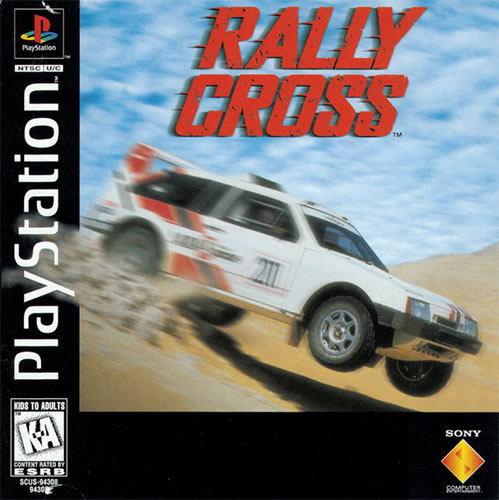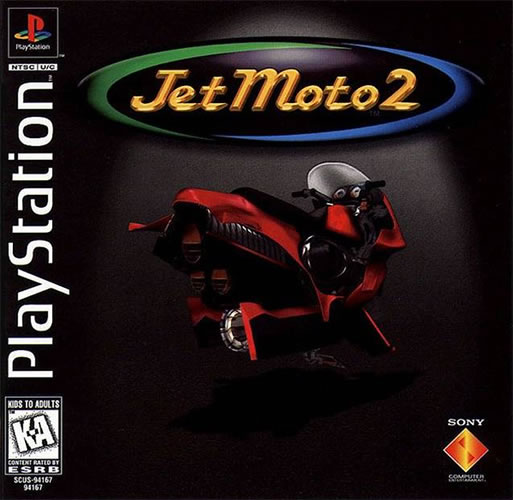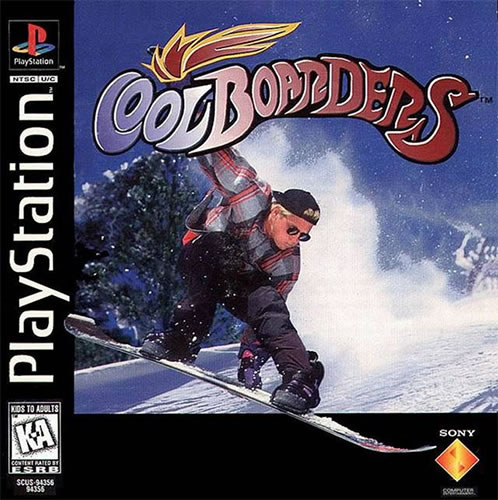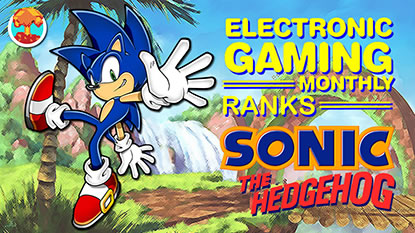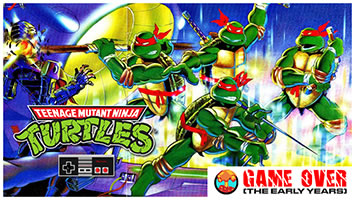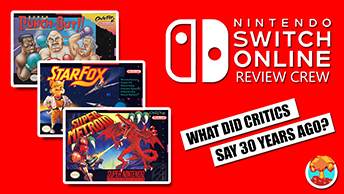- CLASSIC MAGAZINES
- REVIEW CREW
A show recapping what critics thought back
when classic games first came out! - NEXT GENERATION'S BEST & WORST
From the worst 1-star reviews to the best
5-stars can offer, this is Next Generation! - NINTENDO POWER (ARCHIVE)
Experience a variety of shows looking at the
often baffling history of Nintendo Power! - MAGAZINE RETROSPECTIVE
We're looking at the absolutely true history of
some of the most iconic game magazines ever! - SUPER PLAY'S TOP 600
The longest and most ambitious Super NES
countdown on the internet! - THEY SAID WHAT?
Debunking predictions and gossip found
in classic video game magazines! - NEXT GENERATION UNCOVERED
Cyril is back in this spin-off series, featuring the
cover critic review the art of Next Generation! - HARDCORE GAMER MAGAZING (PDF ISSUES)
Download all 36 issues of Hardcore Gamer
Magazine and relive the fun in PDF form!
- REVIEW CREW
- ELECTRONIC GAMING MONTHLY
- ELECTRONIC GAMING MONTHLY RANKS
From Mario to Sonic to Street Fighter, EGM
ranks classic game franchises and consoles! - ELECTRONIC GAMING MONTHLY BEST & WORST
Counting down EGM’s best and worst reviews
going year by year, from 1989 – 2009! - ELECTRONIC GAMING BEST & WORST AWARDS
11-part video series chronicling the ups and
downs of EGM’s Best & Worst Awards!
- ELECTRONIC GAMING MONTHLY RANKS
- GAME HISTORY
- GAME OVER: STORY BREAKDOWNS
Long-running series breaking down game
stories and analyzing their endings! - A BRIEF HISTORY OF GAMING w/ [NAME HERE]
Real history presented in a fun and pithy
format from a variety of game historians! - THE BLACK SHEEP
A series looking back at the black sheep
entries in popular game franchises! - INSTANT EXPERT
Everything you could possibly want to know
about a wide variety of gaming topics! - FREEZE FRAME
When something familiar happens in the games
industry, we're there to take a picture! - I'VE GOT YOUR NUMBER
Learn real video game history through a series
of number-themed episodes, starting at zero! - GREAT MOMENTS IN BAD ACTING
A joyous celebration of some of gaming's
absolute worst voice acting!
- GAME OVER: STORY BREAKDOWNS
- POPULAR SHOWS
- DG NEWS w/ LORNE RISELEY
Newsman Lorne Riseley hosts a regular
series looking at the hottest gaming news! - REVIEW REWIND
Cyril replays a game he reviewed 10+ years
ago to see if he got it right or wrong! - ON-RUNNING FEUDS
Defunct Games' longest-running show, with
editorials, observations and other fun oddities! - DEFUNCT GAMES QUIZ (ARCHIVE)
From online quizzes to game shows, we're
putting your video game knowledge to the test!- QUIZ: ONLINE PASS
Take a weekly quiz to see how well you know
the news and current gaming events! - QUIZ: KNOW THE GAME
One-on-one quiz show where contestants
find out if they actually know classic games! - QUIZ: THE LEADERBOARD
Can you guess the game based on the classic
review? Find out with The Leaderboard!
- QUIZ: ONLINE PASS
- DEFUNCT GAMES VS.
Cyril and the Defunct Games staff isn't afraid
to choose their favorite games and more! - CYRIL READS WORLDS OF POWER
Defunct Games recreates classic game
novelizations through the audio book format!
- DG NEWS w/ LORNE RISELEY
- COMEDY
- GAME EXPECTANCY
How long will your favorite hero live? We crunch
the numbers in this series about dying! - VIDEO GAME ADVICE
Famous game characters answer real personal
advice questions with a humorous slant! - FAKE GAMES: GUERILLA SCRAPBOOK
A long-running series about fake games and
the people who love them (covers included)! - WORST GAME EVER
A contest that attempts to create the worst
video game ever made, complete with covers! - LEVEL 1 STORIES
Literature based on the first stages of some
of your favorite classic video games! - THE COVER CRITIC
One of Defunct Games' earliest shows, Cover
Critic digs up some of the worst box art ever! - COMMERCIAL BREAK
Take a trip through some of the best and
worst video game advertisements of all time! - COMIC BOOK MODS
You've never seen comics like this before.
A curious mix of rewritten video game comics!
- GAME EXPECTANCY
- SERIES ARCHIVE
- NINTENDO SWITCH ONLINE ARCHIVE
A regularly-updated list of every Nintendo
Switch Online release, plus links to review! - PLAYSTATION PLUS CLASSIC ARCHIVE
A comprehensive list of every PlayStation
Plus classic release, including links! - RETRO-BIT PUBLISHING ARCHIVE
A regularly-updated list of every Retro-Bit
game released! - REVIEW MARATHONS w/ ADAM WALLACE
Join critic Adam Wallace as he takes us on a
classic review marathon with different themes!- DEFUNCT GAMES GOLF CLUB
Adam Wallace takes to the links to slice his way
through 72 classic golf game reviews! - 007 IN PIXELS
Adam Wallace takes on the world's greatest spy
as he reviews 15 weeks of James Bond games! - A SALUTE TO VAMPIRES
Adam Wallace is sinking his teeth into a series
covering Castlevania, BloodRayne and more! - CAPCOM'S CURSE
Adam Wallace is celebrating 13 days of Halloween
with a line-up of Capcom's scariest games! - THE FALL OF SUPERMAN
Adam Wallace is a man of steel for playing
some of the absolute worst Superman games! - THE 31 GAMES OF HALLOWEEN
Adam Wallace spends every day of October afraid
as he reviews some of the scariest games ever! - 12 WEEKS OF STAR TREK
Adam Wallace boldly goes where no critic has
gone before in this Star Trek marathon!
- DEFUNCT GAMES GOLF CLUB
- DAYS OF CHRISTMAS (ARCHIVE)
Annual holiday series with themed-episodes
that date all the way back to 2001!- 2015: 30 Ridiculous Retro Rumors
- 2014: 29 Magazines of Christmas
- 2013: 29 Questionable Power-Ups of Christmas
- 2012: 34 Theme Songs of Christmas
- 2011: 32 Game Endings of Christmas
- 2010: 31 Bonus Levels of Christmas
- 2009: 30 Genres of Christmas
- 2008: 29 Controls of Christmas
- 2007: 34 Cliches of Christmas
- 2006: 33 Consoles of Christmas
- 2005: 32 Articles of Christmas
- 2004: 31 Websites of Christmas
- 2003: 29 Issues of Christmas
- 2002: 28 Years of Christmas
- 2001: 33 Days of Christmas
- NINTENDO SWITCH ONLINE ARCHIVE
- REVIEW ARCHIVE
- FULL ARCHIVE
PlayStation Plus: 1990s Critics Review Cool Boarders, Rally Cross & Jet Moto 2
If you've been following our Review Crew series, then you already know that we've finally covered every single game on Nintendo Switch Online. Unfortunately, while doing that, I ended up falling behind when it came to the PlayStation Plus classic game library. With a handful of recent releases in need of the Review Crew treatment, this is going to be the first of several recap episodes where we get caught up on PlayStation games. I'm talking about classic racing games like Rally Cross, Cool Boarders and Jet Moto 2. Sure, these were added to PS Plus months ago, but I still need to ask: Are any of these games worth playing? To answer that question, I decided to flip through the pages of Electronic Gaming Monthly, GamePro, Edge and more classic magazines to see what the critics said back when these games came out. I hope you have the need for speed, because this is going to be another fast-paced episode of PlayStation Plus Review Crew.
After seeing the success of titles like Ridge Racer, wipEout and Jet Moto, Sony knew that ‘90s gamers had a real hunger for racing games. And it wasn't just on the PlayStation, as some of Sega's biggest Saturn hits also involved driving fast, such as Daytona USA and Sega Rally Championship. Between the 3D graphics and the more advanced hardware, developers were suddenly able to create amazing looking games that conveyed a sense of speed that you couldn't get in the 16-bit generation, and racing games were the first genre to really benefit. Rally Cross was, of course, Sony's answer to Sega Rally. It brought the racing genre back down to Earth with courses that that were simultaneously realistic and incredibly dangerous, spanning the globe for unique locations that were genuinely fun to race. This was hyped up to be the next-generation of racing games, complete with unsurpassed graphics, tons of vehicles and even a cool four-player mode. Did Rally Cross live up to the hype?
In the case of Electronic Gaming Monthly, the answer to that question is a resounding YES! Kraig went as far as to call it “one of the most innovative racing games” he's played. “Rally Cross is very much like Sega Rally, but much more involving and difficult. What makes this racer so original is that your vehicle can flip over, jump uncontrollably and crash if enough driving skill isn't used. Not many games dare to be different, and gamers should give this one a try.” Dean agreed, asking and answering the question on everybody's mind: “Is this Sony's answer to Sega Rally? Oh yes. While not as fast as Sega Rally, this game gives fans the better driving experience overall. Some of the tracks are better suited for all-out speed, while others, like the Oasis sand track, call for more finesse and skill, especially to keep the cars upright. Despite some view annoyances and the frequency of tipping, this game is very good.” EGM gave Rally Cross an average score of 8.75 out of 10.
This is basically where most critics sat in 1997. You saw Game Fan go a little bit higher with an 89%, while GamePro went a little bit lower with a 4 out of 5. That's exactly the same score as Next Generation, who had a lot to say on the game: “The graphics featured in Rally Cross are excellent for the most part. The six distinct tracks recreate an exquisitely detailed environment that looks absolutely real from a distance. The only real complaint, at least about the graphics, involves the over-pixelated splashing mud and water. On the other hand, the look of the dust kicked up by tires is rather beautiful. Gamers who look for intense, heart-pounding speed in racing games may be a little disappointed with Rally Cross's gameplay, which has a more realistic emphasis in depicting the terrain-influenced nature of Rally racing. What the game lacks in outright speed, however, is more than made up for by the strategy that is required to select the best line through the undulating tracks. With a plethora of tracks and two-player split-screen action, the depth of Rally Cross exceeds that of the mighty Sega Rally Championship.”
It's probably worth mentioning that not everybody liked Rally Cross. Computer & Video Games was thoroughly underwhelmed by this 32-bit racer, giving it a surprisingly low 2 out of 5. “While there are plenty of options, lots of cars and even a few original ideas, none of the game seems to stand out as being amazing. This is a racer, the likes of which we've seen before. Two years ago it would have been hailed as amazing, now it is sadly left at the back of the starting grid. Not entirely without merit, this is a very though game to complete. I'm not sure many will want to stick with what is a rather average game. On the whole, it's one to avoid, there are loads of great racing games on the PlayStation, Rally Cross just isn't one of them. A pity.”
Honestly, it's like he was playing a completely different game. While it's certainly dated by today's standards, I am much more in line with the critic consensus than CVG's contrarian take. Check it out for yourself on PlayStation Plus.
When we covered the original Jet Moto, I was genuinely surprised by the massive split between critics. Of all the early PlayStation releases, this near-future racing game was the most polarizing, with some critics giving it near-perfect scores, while others calling it an absolute failure. Having just come off of the success of Twisted Metal 2, SingleTrac looked like they were up for the challenging of uniting the critics around a more polished and much-improved sequel. Did that happen? No. Not even close. Jet Moto 2 was just as polarizing, with critics either loving or hating it. What's interesting is who changed their mind and why.
One of the biggest moves came from Electronic Gaming Monthly. When they reviewed the original Jet Moto, they gave it a high score of 9.25 out of 10. Jet Moto 2, on the other hand, could only muster up a 5.9 out of 10. That is a massive drop. Dan put it this way: “It can't be a good thing when, while playing this game, all I can think of are ways to improve it. Jet Moto 2 has some of the most original racing tracks around, but they were designed with looks in mind, not functionality. The tracks usually punish you for going too fast – but this is a racing game! Controls needs a lot of work. For patient gamers only.” HG echoed those thoughts, though framed it as an outsider to the genre: “First off, I'm not a big fan of racers. Jet Moto 2's bumpy-and-jittery control made it tough for me to get into it. Granted, this one's an improvement over the last game, but it seems like more of the same rather than anything new. Fans of Jet Moto will surely like this game, but its polygons and control just weren't enough to keep me playing.”
While EGM's change in score may be extreme, they weren't alone. For example, Next Generation went from giving the original a score of 4 out of 5 down to a 3 out of 5 for the sequel. Die Hard Game Fan, on the other hand, slightly preferred Jet Moto 2, giving it an 89% over the original's 87%. However, one of the bigger shifts came from GamePro, who gave that first Jet Moto game a shockingly low 2.5 out of 5. This time around they gave it a much-improved 4 out of 5, praising the “smooth-scrolling 3D tracks and bright, detailed graphics create believable racing environments and a real sense of speed. However, the intense pixelization on some levels can make you lose sight of the track. As for the controls, the vehicles are quite sensitive, but respond well. Real-time physics apply, so button mashers will be easily frustrated. The in-race effects are adequate, but the hard-rock riffs grow tedious after a while. Fortunately, you can customize the music volume along with the other features. While not perfect, Jet Moto 2 provides enough fun and new features to warrant a spin around your PlayStation.”
And then there's Computer & Video Games, a magazine that was disappointed with the first game and equally disappointed by the sequel. Giving both installments a score of 2 out of 5, CVG argued that “The problem with the original were the messy graphics and unresponsive controls. Not much has changed, except this game plays slightly better than the original. You're still racing around a mixture of water and land courses on a strange hybrid craft that is part jet ski, part hover bike and the graphics are still messy. Compared to the original, though, they are slightly better and faster. This seems a real cash-in, aimed at fans of the original. Yes, it's a little better, but not by much.”
Now, I should probably point out that Sony did release a second version of Jet Moto 2 when it hit the Greatest Hits collection. This “Championship Edition” has improved framerate and tweaked some of the race options. Would that have made a big difference to the review scores? Probably not, but we'll never know. Now you can see which side of the Jet Moto 2 divide you land on when you play it on PlayStation 5.
While video game developers had tinkered around with both skiing and surfing games in the past, they were surprisingly slow when it came to snowboarding. However, as the sport continued to gain popularity in the 1990s, it was only a matter of time before somebody turned shredding into video game greatness. While I'm not sure “greatness” is the word I would use to describe Cool Boarders, you have to hand it to UEP Systems for getting the most out of their extreme sports franchise. Between 1996 and 2001, the company managed to release four main series installments, plus four more spin-offs that were released on everything from the Dreamcast to Neo Geo Pocket Color. For a blip in time, this was the go-top snowboarding series. And then SSX came out and changed all that. But we're not here to talk about SSX, so let's take a look back at what the critics said about Cool Boarders in 1996.
Now, look, you might have nostalgia for this series, but the critics were not impressed at the time. For example, Electronic Gaming Monthly shrugged and gave the game an average score of 7 out of 10. Kraig concluded that “Cool Boarders is a pretty hard game to get a handle on because racing on snowboards offers interesting racing physics. The graphics are decent, and the CD soundtrack adds a lot to the attitude of the game. All in all, once you get the hang of it, Cool Boarders is reasonably fun, but since there are so many great racing games, only pick this up if you are a fan of snowboarding or ‘extreme' sports.” Dean agreed, explaining that if you can “overlook the blocky graphics and line pop-up problems, Cool Boarders is not too bad. Three mountains provide varying degrees of difficulty, translating into how fast players can speed down them. The game could use more options and variables, but for those who liked Extreme Games, this one is similar.”
Believe it or not, EGM gave this game one of the higher scores. If you were reading other reviews at the time, then it was a lot more likely to see scores in the 60% range. You certainly saw that when Computer & Video Games gave Cool Boarders a so-so 3 out of 5, which is exactly the same score you saw from the notoriously grumpy Next Generation magazine. And then there's Edge, who went with a 6 out of 10 and explained that the low scores were easy to predict. “Given the rising popularity in the sport, a 32-bit snowboarding simulation was inevitable. It was perhaps also a sure thing that the first example would be intrinsically flawed – if only because it is something never before attempted. Despite teething problems, though, Cool Boarders does have praise-worthy points. The three initially available courses are exciting and well-structured, and the feeling of speed and gut-churning momentum you experience as your boarder swoops down the sometimes almost vertical slopes is surprisingly intense. However, because players can race only against a constantly ticking clock and not, for example, times set by other players, the experience is a rather solitary one.”
Of all the magazines on the shelves in 1996, GamePro was the friendliest to Cool Boarders. Giving it a solid 4 out of 5, they praised the gameplay: “The controls allow for tight handling and make performing tricks a breeze. Although the graphics show minor breakup, they're still well-animated in the popular polygon style. The music fits perfectly. However, the announcer never stops making mundane comments. If you can't go big on the mountain, do some shreddin' at home with Cool Boarders. It's a fun ride.”
Honestly, I think the 60% - 70% range makes a lot of sense for this game. As Edge pointed out, it's hard to be first, and you can tell that a lot of future snowboarding games learned from the mistakes made in this game. As they say, Cool Boarders crawled so that games like SSX and Amped could shred!
| Publication | Scores |
|---|---|
| Game Fan | 89% |
| Electronic Gaming Monthly | 8.75/10 |
| GamePro | 4/5 |
| Next Generation | 4/5 |
| Computer & Video Games | 2/5 |
| AVERAGE SCORE | 75% |
In the case of Electronic Gaming Monthly, the answer to that question is a resounding YES! Kraig went as far as to call it “one of the most innovative racing games” he's played. “Rally Cross is very much like Sega Rally, but much more involving and difficult. What makes this racer so original is that your vehicle can flip over, jump uncontrollably and crash if enough driving skill isn't used. Not many games dare to be different, and gamers should give this one a try.” Dean agreed, asking and answering the question on everybody's mind: “Is this Sony's answer to Sega Rally? Oh yes. While not as fast as Sega Rally, this game gives fans the better driving experience overall. Some of the tracks are better suited for all-out speed, while others, like the Oasis sand track, call for more finesse and skill, especially to keep the cars upright. Despite some view annoyances and the frequency of tipping, this game is very good.” EGM gave Rally Cross an average score of 8.75 out of 10.
This is basically where most critics sat in 1997. You saw Game Fan go a little bit higher with an 89%, while GamePro went a little bit lower with a 4 out of 5. That's exactly the same score as Next Generation, who had a lot to say on the game: “The graphics featured in Rally Cross are excellent for the most part. The six distinct tracks recreate an exquisitely detailed environment that looks absolutely real from a distance. The only real complaint, at least about the graphics, involves the over-pixelated splashing mud and water. On the other hand, the look of the dust kicked up by tires is rather beautiful. Gamers who look for intense, heart-pounding speed in racing games may be a little disappointed with Rally Cross's gameplay, which has a more realistic emphasis in depicting the terrain-influenced nature of Rally racing. What the game lacks in outright speed, however, is more than made up for by the strategy that is required to select the best line through the undulating tracks. With a plethora of tracks and two-player split-screen action, the depth of Rally Cross exceeds that of the mighty Sega Rally Championship.”
It's probably worth mentioning that not everybody liked Rally Cross. Computer & Video Games was thoroughly underwhelmed by this 32-bit racer, giving it a surprisingly low 2 out of 5. “While there are plenty of options, lots of cars and even a few original ideas, none of the game seems to stand out as being amazing. This is a racer, the likes of which we've seen before. Two years ago it would have been hailed as amazing, now it is sadly left at the back of the starting grid. Not entirely without merit, this is a very though game to complete. I'm not sure many will want to stick with what is a rather average game. On the whole, it's one to avoid, there are loads of great racing games on the PlayStation, Rally Cross just isn't one of them. A pity.”
Honestly, it's like he was playing a completely different game. While it's certainly dated by today's standards, I am much more in line with the critic consensus than CVG's contrarian take. Check it out for yourself on PlayStation Plus.
| Publication | Scores |
|---|---|
| Game Fan | 89% |
| GamePro | 4/5 |
| PSM | 3.5/5 |
| Next Generation | 3/5 |
| Electronic Gaming Monthly | 5.9/10 |
| Computer & Video Games | 2/5 |
| AVERAGE SCORE | 66% |
One of the biggest moves came from Electronic Gaming Monthly. When they reviewed the original Jet Moto, they gave it a high score of 9.25 out of 10. Jet Moto 2, on the other hand, could only muster up a 5.9 out of 10. That is a massive drop. Dan put it this way: “It can't be a good thing when, while playing this game, all I can think of are ways to improve it. Jet Moto 2 has some of the most original racing tracks around, but they were designed with looks in mind, not functionality. The tracks usually punish you for going too fast – but this is a racing game! Controls needs a lot of work. For patient gamers only.” HG echoed those thoughts, though framed it as an outsider to the genre: “First off, I'm not a big fan of racers. Jet Moto 2's bumpy-and-jittery control made it tough for me to get into it. Granted, this one's an improvement over the last game, but it seems like more of the same rather than anything new. Fans of Jet Moto will surely like this game, but its polygons and control just weren't enough to keep me playing.”
While EGM's change in score may be extreme, they weren't alone. For example, Next Generation went from giving the original a score of 4 out of 5 down to a 3 out of 5 for the sequel. Die Hard Game Fan, on the other hand, slightly preferred Jet Moto 2, giving it an 89% over the original's 87%. However, one of the bigger shifts came from GamePro, who gave that first Jet Moto game a shockingly low 2.5 out of 5. This time around they gave it a much-improved 4 out of 5, praising the “smooth-scrolling 3D tracks and bright, detailed graphics create believable racing environments and a real sense of speed. However, the intense pixelization on some levels can make you lose sight of the track. As for the controls, the vehicles are quite sensitive, but respond well. Real-time physics apply, so button mashers will be easily frustrated. The in-race effects are adequate, but the hard-rock riffs grow tedious after a while. Fortunately, you can customize the music volume along with the other features. While not perfect, Jet Moto 2 provides enough fun and new features to warrant a spin around your PlayStation.”
And then there's Computer & Video Games, a magazine that was disappointed with the first game and equally disappointed by the sequel. Giving both installments a score of 2 out of 5, CVG argued that “The problem with the original were the messy graphics and unresponsive controls. Not much has changed, except this game plays slightly better than the original. You're still racing around a mixture of water and land courses on a strange hybrid craft that is part jet ski, part hover bike and the graphics are still messy. Compared to the original, though, they are slightly better and faster. This seems a real cash-in, aimed at fans of the original. Yes, it's a little better, but not by much.”
Now, I should probably point out that Sony did release a second version of Jet Moto 2 when it hit the Greatest Hits collection. This “Championship Edition” has improved framerate and tweaked some of the race options. Would that have made a big difference to the review scores? Probably not, but we'll never know. Now you can see which side of the Jet Moto 2 divide you land on when you play it on PlayStation 5.
| Publication | Scores |
|---|---|
| GamePro | 4/5 |
| Electronic Gaming Monthly | 7/10 |
| Edge | 6/10 |
| Next Generation | 3/5 |
| Computer & Video Games | 3/5 |
| AVERAGE SCORE | 66% |
Now, look, you might have nostalgia for this series, but the critics were not impressed at the time. For example, Electronic Gaming Monthly shrugged and gave the game an average score of 7 out of 10. Kraig concluded that “Cool Boarders is a pretty hard game to get a handle on because racing on snowboards offers interesting racing physics. The graphics are decent, and the CD soundtrack adds a lot to the attitude of the game. All in all, once you get the hang of it, Cool Boarders is reasonably fun, but since there are so many great racing games, only pick this up if you are a fan of snowboarding or ‘extreme' sports.” Dean agreed, explaining that if you can “overlook the blocky graphics and line pop-up problems, Cool Boarders is not too bad. Three mountains provide varying degrees of difficulty, translating into how fast players can speed down them. The game could use more options and variables, but for those who liked Extreme Games, this one is similar.”
Believe it or not, EGM gave this game one of the higher scores. If you were reading other reviews at the time, then it was a lot more likely to see scores in the 60% range. You certainly saw that when Computer & Video Games gave Cool Boarders a so-so 3 out of 5, which is exactly the same score you saw from the notoriously grumpy Next Generation magazine. And then there's Edge, who went with a 6 out of 10 and explained that the low scores were easy to predict. “Given the rising popularity in the sport, a 32-bit snowboarding simulation was inevitable. It was perhaps also a sure thing that the first example would be intrinsically flawed – if only because it is something never before attempted. Despite teething problems, though, Cool Boarders does have praise-worthy points. The three initially available courses are exciting and well-structured, and the feeling of speed and gut-churning momentum you experience as your boarder swoops down the sometimes almost vertical slopes is surprisingly intense. However, because players can race only against a constantly ticking clock and not, for example, times set by other players, the experience is a rather solitary one.”
Of all the magazines on the shelves in 1996, GamePro was the friendliest to Cool Boarders. Giving it a solid 4 out of 5, they praised the gameplay: “The controls allow for tight handling and make performing tricks a breeze. Although the graphics show minor breakup, they're still well-animated in the popular polygon style. The music fits perfectly. However, the announcer never stops making mundane comments. If you can't go big on the mountain, do some shreddin' at home with Cool Boarders. It's a fun ride.”
Honestly, I think the 60% - 70% range makes a lot of sense for this game. As Edge pointed out, it's hard to be first, and you can tell that a lot of future snowboarding games learned from the mistakes made in this game. As they say, Cool Boarders crawled so that games like SSX and Amped could shred!
HOME |
CONTACT |
NOW HIRING |
WHAT IS DEFUNCT GAMES? |
NINTENDO SWITCH ONLINE |
RETRO-BIT PUBLISHING
Retro-Bit |
Switch Planet |
The Halcyon Show |
Same Name, Different Game |
Dragnix |
Press the Buttons
Game Zone Online | Hardcore Gamer | The Dreamcast Junkyard | Video Game Blogger
Dr Strife | Games For Lunch | Mondo Cool Cast | Boxed Pixels | Sega CD Universe | Gaming Trend
Game Zone Online | Hardcore Gamer | The Dreamcast Junkyard | Video Game Blogger
Dr Strife | Games For Lunch | Mondo Cool Cast | Boxed Pixels | Sega CD Universe | Gaming Trend
Copyright © 2001-2025 Defunct Games
All rights reserved. All trademarks are properties of their respective owners.
All rights reserved. All trademarks are properties of their respective owners.







